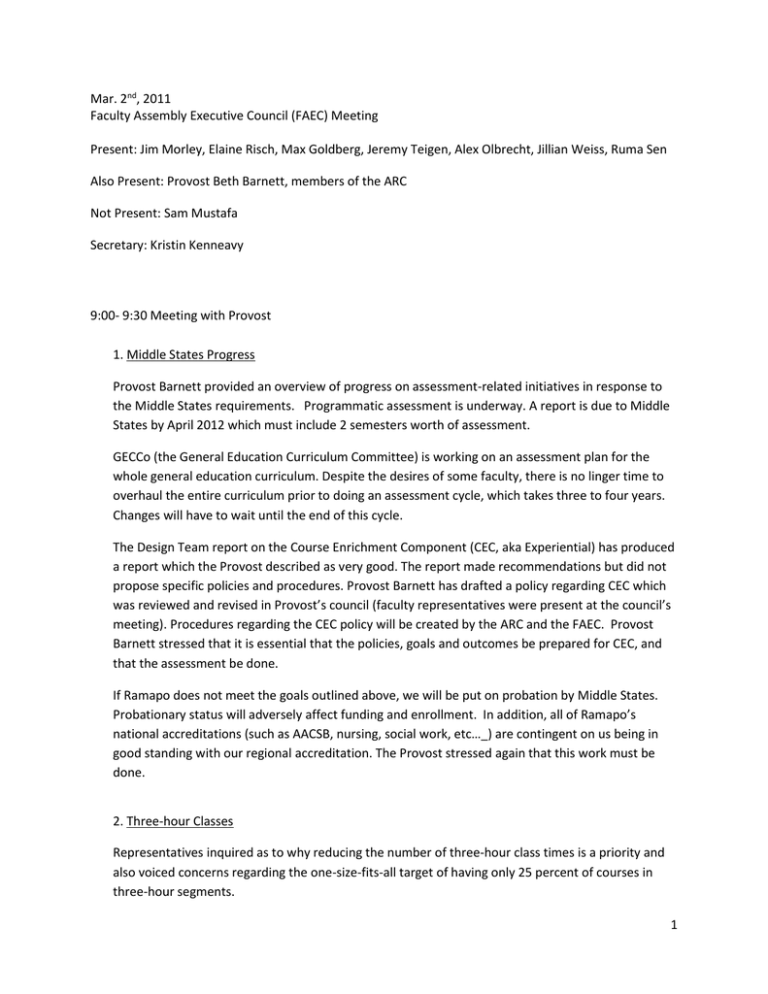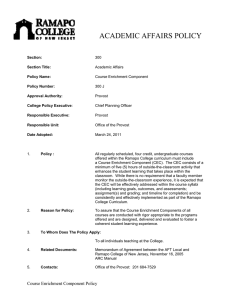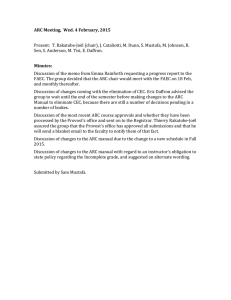Mar. 2 , 2011 Faculty Assembly Executive Council (FAEC) Meeting
advertisement

Mar. 2nd, 2011 Faculty Assembly Executive Council (FAEC) Meeting Present: Jim Morley, Elaine Risch, Max Goldberg, Jeremy Teigen, Alex Olbrecht, Jillian Weiss, Ruma Sen Also Present: Provost Beth Barnett, members of the ARC Not Present: Sam Mustafa Secretary: Kristin Kenneavy 9:00- 9:30 Meeting with Provost 1. Middle States Progress Provost Barnett provided an overview of progress on assessment-related initiatives in response to the Middle States requirements. Programmatic assessment is underway. A report is due to Middle States by April 2012 which must include 2 semesters worth of assessment. GECCo (the General Education Curriculum Committee) is working on an assessment plan for the whole general education curriculum. Despite the desires of some faculty, there is no linger time to overhaul the entire curriculum prior to doing an assessment cycle, which takes three to four years. Changes will have to wait until the end of this cycle. The Design Team report on the Course Enrichment Component (CEC, aka Experiential) has produced a report which the Provost described as very good. The report made recommendations but did not propose specific policies and procedures. Provost Barnett has drafted a policy regarding CEC which was reviewed and revised in Provost’s council (faculty representatives were present at the council’s meeting). Procedures regarding the CEC policy will be created by the ARC and the FAEC. Provost Barnett stressed that it is essential that the policies, goals and outcomes be prepared for CEC, and that the assessment be done. If Ramapo does not meet the goals outlined above, we will be put on probation by Middle States. Probationary status will adversely affect funding and enrollment. In addition, all of Ramapo’s national accreditations (such as AACSB, nursing, social work, etc…_) are contingent on us being in good standing with our regional accreditation. The Provost stressed again that this work must be done. 2. Three-hour Classes Representatives inquired as to why reducing the number of three-hour class times is a priority and also voiced concerns regarding the one-size-fits-all target of having only 25 percent of courses in three-hour segments. 1 Provost Barnett responded that the pedagogical concerns were paramount, especially in relation to faculty considerations. Research indicates that distributed learning is better for students. She also acknowledged that it is easier to schedule courses that occur twice per week. She also stated that the 25 percent goal is in the academic plan. The 25 percent target is to be a rule of thumb and each unit and program should work toward that goal in a sensible manner – disciplinary differences will need to be considered. It was reiterated that many types of classes that need to be in a 3-hour format are already excluded from that target and from the current percentage of courses that are offered in a three-hour block (e.g. labs, capstones, fieldwork, studios, co-ops, etc…). It was also noted that 300/400 level courses might be expected to meet in three-hour blocks, but that 100/200 level courses might work better in a twice per week (e.g. Readings in the Humanities, College English, First Year Seminar). This would include adjunct-taught courses. Provost Barnett reiterated that adjunct concerns should not trump pedagogical concerns in this matter. Rob Mentore, director of the First Year Seminars, was consulted and reportedly does not see a problem with having FYS courses taught twice per week. It was also suggested that, in light of the difficulty in attracting students to Friday afternoon courses, that the schedule might be better in a Monday/Wednesday, Tuesday/Thursday format. Another suggestion was to just separate evening courses from the rest of the schedule and make those M/W, T/R. The Provost acknowledged that these possibilities might be examined. 3. Winter Break/Accelerated Final Grade Submission (Possible FA Motion) President Morley indicated that faculty members are split on the issue of extending the winter break by truncating the grading period, and that changes to the academic calendar would need to carry with them some perceived benefits among the faculty. Some faculty would really prefer a proper winter term - four weeks during which to run an academically rigorous course. However, faculty who teach writing intensive courses are concerned about having less time to grade lengthier final exams and projects. Provost Barnett stated that she will raise the possibility with the cabinet next week. Depending on the calendar in a given year, course could be shifted a week later in May. Offering courses over the Christmas portion of winter break is not working well. She also raised two other points: (1) that student papers could be turned in prior to the last day of class and that (2) convening groups need to discuss what topics are appropriate to be offered in four weeks. The discussion should be motivated by rigor and pedagogy. When asked about the limitations of the shift to a later start date, Provost Barnett stated that students need to graduate before the Memorial Day weekend at the end of May and that state law requires a 15 week semester. As a result, the grading period is one of the only time periods with any flexibility, although graduation could be pushed back a week. For instance, this year, graduation is on the 13th of May, but could have been pushed to the 20th of May. 2 4. May Conference The following questions were posed: (1) What is the best use of the faculty conference time this spring in light of the above? And (2) How much time does this require? Provost Barnett suggested that faculty need to discuss assessment, both at the all-college, unit, and program levels. At least half a day should be devoted to this topic. The Provost also brought up that Ramapo must re-administer the Collegiate Learning Assessment (CLA) again due to low participation among seniors the last time it was given. The CLA is an exam that assesses knowledge derived from general education. It is described as an active learning test; it is problem-based and resources are given. Students may be asked to analyze an argument or create an argument, demonstrate critical thinking, mathematical reasoning and language, or information literacy. Test is given in the fall to 100 first-year students and 100 seniors. Ideally this would be a random sample. This is trend data, not panel data so students are not followed individually over time. Entering SAT scores are used as a control variable. Time at the conference could be devoted to explaining the need for this exam to faculty members. 5. SBR Task Force Initiative Sam Mustafa has met with Provost Barnett about this and will report to FAEC. 6. Schedule Task Force No discussion. 9:30-10:00 meeting with ARC 1. Three Hour Classes The Faculty Assembly has asked that the FAEC and the ARC should look into the matter of threehour courses. ARC hasn’t deliberated on this issue yet, although Emma Rainforth has been reviewing the literature. Taking a survey of faculty member’s opinions won’t work in this case because the results may be biased toward faculty scheduling rather than pedagogy. In general, the literature seems to suggest that distributed learning may be better. Rep. Weiss and Vice Provost Daffron had conferred on this issue prior to the meeting and outlined some key points of information. The goal is meant to be across the college and shouldn’t be interpreted as every convening group or school needing to get down to 25 percent of courses being 3 offered in three hour blocks. In the past, 45 percent of courses were once per week (even when labs, fieldwork, co-ops, etc…were excluded). Progress has already been made; the figure is now down to 37 or 38 percent across the college. Program specific needs continue to be important. The deans must decide, in conjunction with convening groups, how to prioritize the types of courses that require three hour blocks of time (could propose criteria). Adjunct convenience is not the sole argument, although the deans could use their discretion to make an exception. The reduction will happen over time, not all at once. It was reiterated that courses that routinely require three hour formats have been excluded from the denominator and that lecture courses will need to convert in order to reduce this number to the overall target. Much of the concern stems from offering lowerlevel courses once per week (such as First Year Seminar). It was noted that if some units are above 25 percent, then some units will have to be below 25 percent to balance out the all-college goal. It was also pointed out that the recent reduction could be attributed to an increase in the number of online courses (faculty who have lost a three hour slot may just decide to offer the course online instead). Another concern was that, if criteria were established, that professors would simply change their courses to fit the criteria. The concerns of returning students and adult learners were raised and the idea to switch night classes to a MW/TR format was reasserted. Given the interest in potentially redoing the class schedule more generally, focusing too much on three-hour courses could be premature. Representatives asked if numbers of online courses could be provided and whether the percentages could be broken out by convening group. It was suggested that a more concerted reading of the literature was needed and that other institutions approaches should be examined. What is best for the students should be the foremost consideration. Many students work full-time and this makes it easier for them to schedule work (need to keep the current financial climate in mind). 2. Online Course Guidelines There was discussion as to whether the Online Course Guidelines were ready to be voted on at the Faculty Assembly meeting on March 9th. Representatives asked whether some of the concerns raised regarding this document at the last FA meeting had been addressed. Prof. Rainforth responded that no faculty had provided feedback on the document (that required changes) and that it had been posted for a sufficient length of time for faculty to review. The clarifications at the FA meeting were really a review of material that was already present in the document. Prof. Rainforth also stated that the manual was a draft that could be amended over time. The FAEC agreed to deliberate regarding whether the vote on the online manual would be put on the March 9th FA agenda. The ARC agreed to remind faculty to read the document and provide feedback. 4 10:00-11:00 Meeting of FAEC 1. Online Manual Proposal Concerns were raised regarding some of the language in the manual regarding the suggested criteria that deans may use to decide whether a course should be offered online. These included demand (which cannot necessarily be known in advance), rigor, and the availability of student support services. Some representatives were concerned about the deans being given veto power over an online course when such power should be shared with convening groups. Rep. Weiss agreed to draw up a document about concerns related to online courses and to circulate it via email. 2. Design Team Report The readiness of the Design Team report for inclusion on the FA agenda was discussed. Many representatives voiced concerns regarding the document and felt that it should not be discussed until the March 23rd FA meeting. Some of the concerns included the proposed schedule of tasks (especially the year-long timeframe allotted for analysis), the suggested weighting of the CEC component within a course’s allocation of points (10 percent, corresponding to 5 of the required 50 hours of course time), the perceived lack of definition of what constitutes CEC, and the lack of consultation with the Faculty Assembly. Another concern was the process through which the CEC proposals/recommendations might be expected to go. Since the Design Team was not chartered by the Faculty Assembly or FAEC, it does not report to these bodies, but might be expected to have to go through the ARC if curricular changed may result. It was observed that the Design Team was comprised of many non-faculty members. It was suggested that proposals stemming from this committee should actually be presented to FA by the ARC and not by the Design Team. It was noted that Middle States is the impetus for re-examining the CEC. It is important that we do so to stay out of probation. It was suggested that further discussion with the ARC and Design Team on this issue may be warranted. The ARC had already drafted and circulated a response memo to the Design Team’s report, which stated that goals, outcomes, and learning objectives be developed for CEC as well, as per Middle States directions. In the context of the above conversation, it was suggested that this should really have been a matter for the ARC, and that the ARC is often overwhelmed with tasks. It was suggested that the size of the ARC be doubled to accommodate subcommittees. It was proposed that, rather than providing further structure for the Course Enrichment Component (CEC), that an alternative plan might be to extend the in-class time required for 5 each class session to one hour and forty minutes. This could be done in conjunction with examining three hour classes and the class schedule in general. The history of the CEC was discussed and several representatives indicated that they had heard that the origins of the CEC were based on the requirements for hours by the State of NJ, not necessarily on pedagogical considerations. The CEC was implemented when the course load per semester was switched from 4/4 to 3/3. It was suggested that the CEC does more to support Student Affairs/Student Development programming than to enrich classroom experience. Concerns were raised regarding the extent to which students pay for services such as security and cleaning at events, which are costly but unrelated to student learning. 3. May Conference It was suggested that a few hours of the conference be devoted to assessment-related issues and that these be focused on only those tasks that need to be accomplished. Representatives were not supportive of the inclusion of workshops. Other suggestions included revisiting the Middle States suggestions that faculty be placed on committees that deal with financial issues at the college and dealing with issues of diversity, and that some time be devoted to setting the FA agenda for the 2011/2012 academic year. 4. Governance Review The Governance Review Committee (GRC) and the FAEC both have concerns that, under the current by-laws, it appears that a full two-thirds of all faculty members must vote “yes” to adopt the amendments to the by-laws proposed by the GRC (not just two-thirds of all faculty who actually vote). This is problematic due to the generally low level of turnout among faculty members in such votes; it is difficult to get two-thirds of the faculty to vote at all, let alone vote “yes”. It is clear, however, that the vote be done via mail-in ballot. The article in question is Article 8. A lengthy discussion of the interpretation of the article that stipulates the above ensued. Representatives were split among a number of viewpoints. Some suggested that the article should be interpreted to mean two-thirds of all faculty must approve the amendments, some felt that there was sufficient ambiguity in the language that it may be up to the parliamentarian to settle the final interpretation (if one could be agreed upon in the FAEC). It was also suggested that an amendment be approved by two-thirds of the FA to change the article to make it more clear what the definition of a quorum was in this instance. 6 After discussion, Rep. Risch made the following motion: Move to adopt the proposal that the FAEC hereby states that Article 8 of the by-laws is interpreted to mean that a two-thirds majority vote of the full membership of the Faculty Assembly is needed to amend the by-laws (submitted by mail-in ballot). Friendly amendment (Rep. Weiss): Move that the language of the above motion be changed to read “…the FAEC hereby clarifies…” and that it be noted that this does not actually constitute a change in the by-laws. There was some discussion to make certain that everyone had understood the motions as written above. A vote was taken. Both motions were unanimously approved. The Parliamentarian (Rep. Olbrecht) abstained from both votes. Minutes approved. Meeting adjourned. 7

